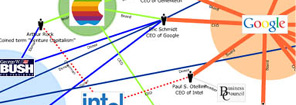It is wonderful to see so many personal visualizations of time. It reminds me of the first grade science class when I asked the students to define “time” as an introduction to stop-motion animation. Those first graders sought fairly literal definitions, I wonder what their responses would have been like if asked to draw time.
I didn’t take the time to submit anything to this website, but I enjoyed the following abstract representations of time.

“Time to me starts off going extremely slow, days are longer, months and years seem to drag on forever. But once you hit college and start developing a more sophisticated way of life, there is never enough time. Before you know it, you are old, gray and wrinkly.”
Personally, as time goes on I feel like the present moment is more expansive, yet fleeting — more like this next one:

“This is the way I view the passing of time. Many things happen and then time keeps pushing forward adding new events and memories. The newer events seem to take up more space than the old because we “weed” out what we don’t really need to remember in order to save space for the new; yet, we never forget the old.”
(via information aesthetics)



